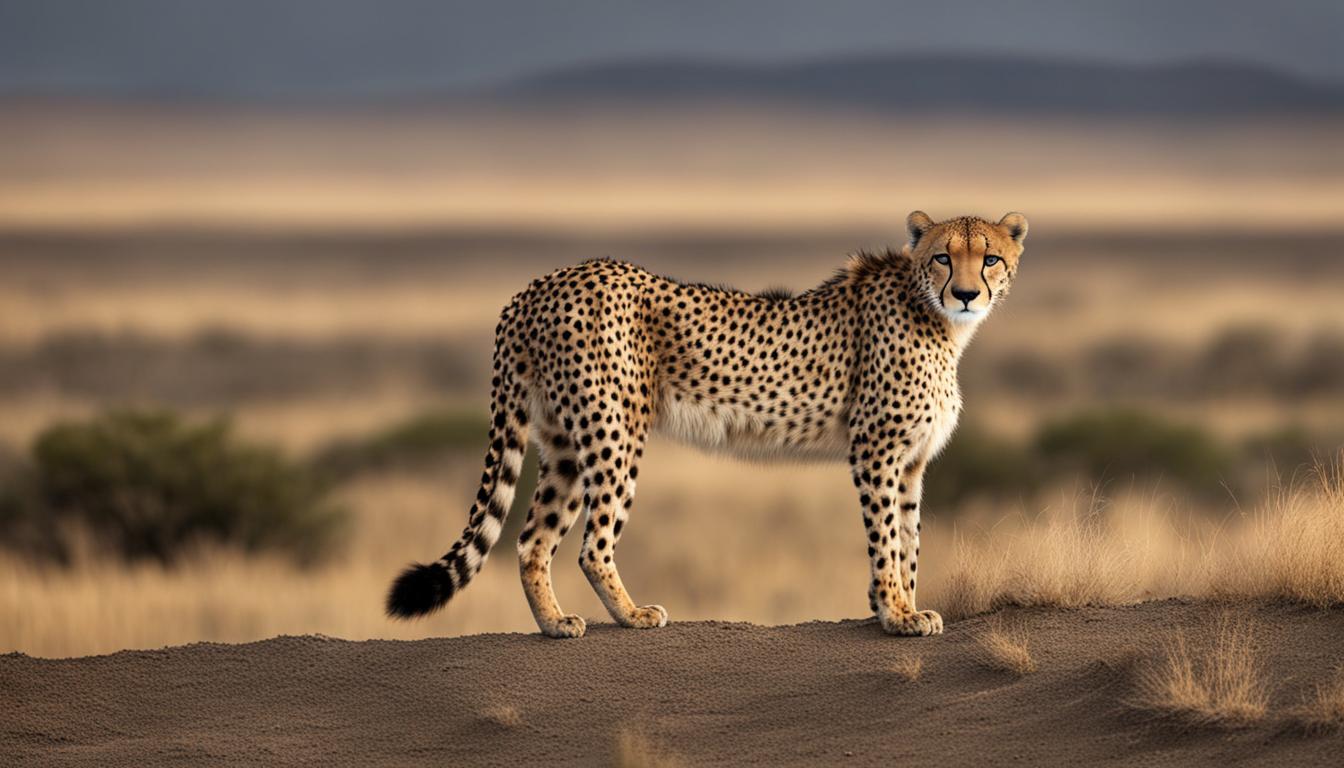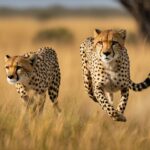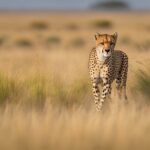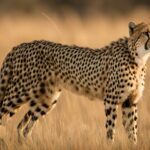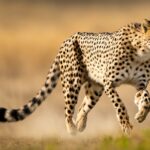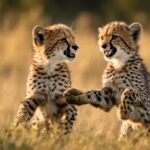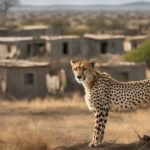Cheetah conservation status, endangered cheetahs, cheetah population decline – these are the pressing issues that need our attention. Cheetahs, magnificent creatures known for their speed and agility, are facing a grave threat of extinction. The combined impact of climate change, hunting by humans, and habitat destruction has pushed them to the brink.
Their low rate of reproductive success and lack of genetic variability further jeopardize their survival. In fact, the global cheetah population has declined by about 50% in the last four decades. Today, there are fewer than 8,000 African cheetahs and possibly fewer than 50 Asian cheetahs left in the wild.
This alarming decline in cheetah populations demands immediate action. We must join forces to protect these magnificent creatures and secure their future in the wild. Through conservation efforts and raising awareness, we can make a difference in preserving cheetahs for generations to come.
Evolution and History of Cheetahs
The cheetah, one of nature’s most fascinating and iconic creatures, has a rich evolutionary history. Studies suggest that cheetahs likely descended from the same ancestor as the American puma, with a divergence occurring around five to six million years ago. However, the cheetah lineage experienced significant events that shaped its current genetic makeup and population dynamics.
An extinction event around 10,000 to 12,000 years ago devastated cheetah populations in North America and Europe, resulting in their disappearance from these regions. This event, along with other factors such as habitat fragmentation and hunting pressures, led to genetic bottlenecks in the surviving populations. As a result, cheetahs today exhibit remarkably low genetic variability and a high degree of genetic similarity. This lack of genetic diversity poses challenges for their long-term survival and adaptability.
“The cheetah’s genetic bottleneck is a sobering reminder of the impact human activities can have on fragile populations,” says Dr. Jane Ellis, a wildlife geneticist. “It’s crucial that we prioritize conservation efforts to protect these magnificent animals and preserve their unique genetic heritage.”
Genetic studies have shown that cheetah populations have over 90% homozygosity, meaning that individuals have a high degree of genetic similarity within the population. This genetic uniformity increases the risk of disease susceptibility and reduces overall reproductive success. Additionally, cheetahs exhibit physical signs of inbreeding, such as skull asymmetry and an increased prevalence of skin graft rejections. These factors highlight the urgent need to address the genetic challenges faced by cheetahs and ensure their long-term survival.
The Importance of Genetic Variability
Genetic variability is essential for the survival and adaptability of any species. It allows for the expression of diverse traits and helps populations respond to changing environmental conditions. In the case of cheetahs, their low genetic variability makes them vulnerable to disease outbreaks, reduces their ability to adapt to new habitats, and limits their reproductive success. Conservation efforts must prioritize strategies that aim to increase genetic diversity and minimize the risks associated with inbreeding.
| Comparing Genetic Variability in Cheetahs and Other Big Cats | |
|---|---|
| Species | Estimated Genetic Variability |
| African Lion | 20-30% |
| Leopard | 10-15% |
| Tiger | 15-20% |
| Cheetah | Less than 1% |
Future Challenges and Conservation Efforts
Addressing the genetic challenges faced by cheetahs requires collaborative efforts from scientists, conservation organizations, and policymakers. Conservation programs must prioritize the establishment of interconnected habitats to facilitate gene flow and increase genetic diversity among cheetah populations. Furthermore, initiatives such as captive breeding programs and translocations can help introduce new genetic material into populations with low variability.
By understanding the evolutionary history and genetic constraints of cheetahs, conservationists can develop effective strategies to ensure the long-term survival of this remarkable species. Protecting the genetic diversity of cheetah populations is not only crucial for their own survival but also contributes to the overall health and resilience of our planet’s biodiversity.
Current Conservation Status of Cheetahs
The cheetah, a majestic and iconic big cat species, is currently facing a precarious conservation status. According to the World Conservation Union, cheetahs are classified as vulnerable or endangered in all 32 countries where they are found. This classification highlights the urgent need for concerted efforts to protect and preserve these incredible creatures.
The global cheetah population is estimated to be around 9,000 to 12,000 individuals, with the majority found in Africa. However, the cheetah’s habitat has been greatly reduced, leading to fragmented populations. This habitat loss, coupled with a decline in available prey and increased competition from other predators, further threatens the survival of cheetah populations.
To compound the challenges, illegal trade in cheetahs presents yet another threat. The demand for live cheetahs in the illegal pet trade has led to the capture and trafficking of these animals, further impacting their numbers. This illegal trade not only disrupts cheetah populations but also contributes to their decline in the wild.
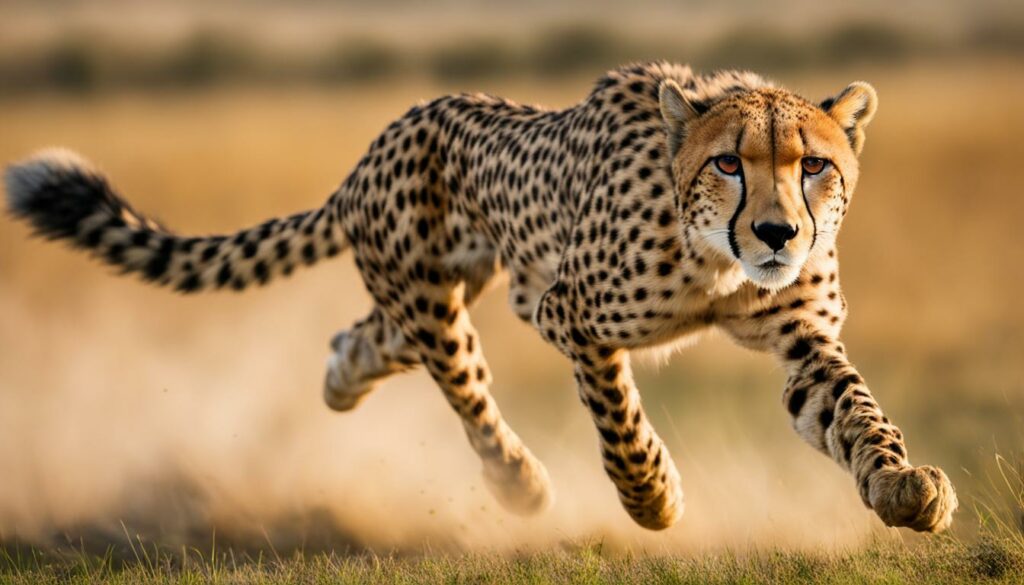
Conservation efforts are vital for safeguarding the future of cheetahs. Various organizations are working tirelessly to protect cheetah habitats, combat illegal trade, and raise awareness about the importance of cheetah conservation. However, the battle is far from over, and the collective actions of individuals, communities, and governments are crucial in turning the tide and securing a future for these magnificent creatures.
Table: Cheetah Conservation Status by Country
| Country | Conservation Status |
|---|---|
| South Africa | Endangered |
| Kenya | Endangered |
| Tanzania | Vulnerable |
| Botswana | Endangered |
| Iran | Endangered |
| India | Critically Endangered |
The table above provides a snapshot of the conservation status of cheetahs in select countries. It underscores the urgent need for targeted conservation efforts in various regions to protect these magnificent animals and ensure their survival for generations to come.
Threats to Cheetahs and Conservation Efforts
Conserving cheetah populations is crucial to ensure the survival of this magnificent species. However, cheetahs face numerous threats that require urgent attention. Habitat destruction caused by agriculture, the construction of roads, and human settlements is one of the primary challenges. As their natural habitat shrinks, cheetahs are forced into smaller and fragmented areas, making it difficult for them to find suitable territories and prey.
The illegal trade in live cheetahs and poaching for their skin are additional threats that exacerbate the decline of cheetah populations. The demand for live cheetahs as exotic pets or status symbols drives a thriving illegal trade market. These practices not only disrupt natural ecosystem balance but also contribute to the further decline of cheetah populations. Poaching, specifically for their skin, also poses a significant risk to cheetah survival.
To combat these threats, various cheetah conservation organizations are actively engaged in protecting cheetahs and their habitats. These organizations work towards habitat restoration, anti-poaching efforts, and community engagement. By restoring and preserving cheetah habitats, these organizations provide a safe environment for cheetahs to thrive. Anti-poaching measures help prevent illegal hunting and trade, ensuring the long-term survival of the species.
Education and community outreach play a crucial role in cheetah conservation efforts. By raising awareness about the importance of cheetahs and their conservation, these organizations encourage local communities to become active participants in safeguarding cheetah populations. Additionally, conservation organizations collaborate with governments and international bodies to strengthen legislation against habitat destruction, illegal trade, and poaching.
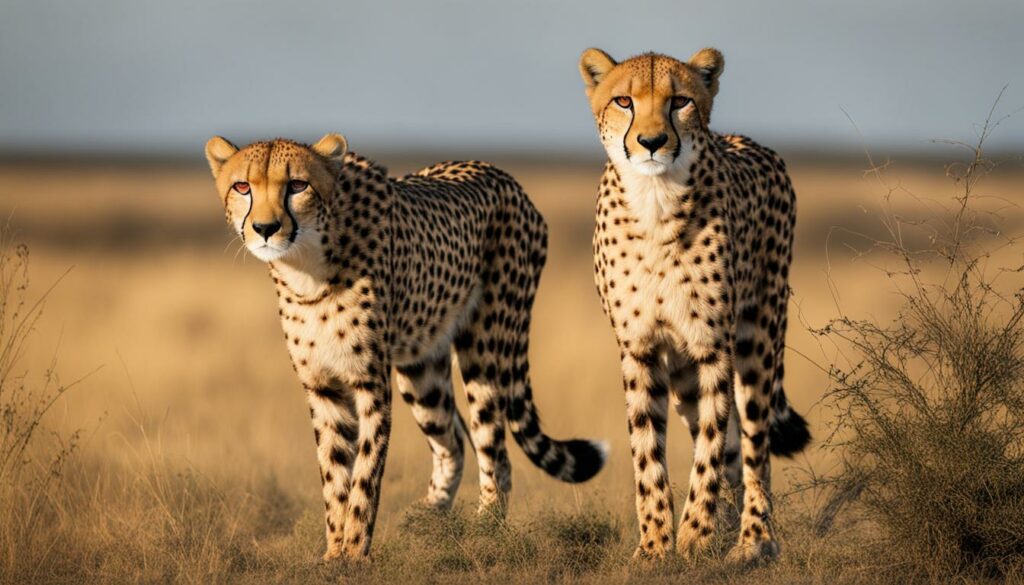
Through collective efforts, we can protect cheetahs and secure a future for them. Supporting cheetah conservation organizations, spreading awareness, and promoting responsible tourism are some ways individuals can contribute to the preservation of these magnificent creatures.
Preserving Cheetah Populations and Taking Action
The conservation of cheetahs is crucial to ensuring the survival of this magnificent species. To combat the decline of cheetah populations and contribute to their species’ survival, various conservation programs have been implemented. These initiatives focus on preserving viable populations and managing the genetic diversity within cheetah populations.
Habitat Restoration and Anti-Poaching Measures
Habitat restoration plays a vital role in cheetah conservation efforts. By restoring and protecting their natural habitats, conservationists provide cheetahs with suitable environments for hunting and breeding. This includes efforts to reduce habitat destruction caused by agriculture, roads, and settlements.
Anti-poaching measures are also essential in protecting cheetah populations. Poaching poses a significant threat to these magnificent animals, driven by the illegal trade in live cheetahs and the demand for their skins. Conservation organizations work tirelessly to combat these activities and enforce wildlife protection laws.
Community Engagement and Education
Engaging local communities in cheetah conservation efforts is crucial for long-term success. By educating communities about the importance of preserving cheetah populations, conservation organizations can foster a sense of ownership and pride in protecting these iconic animals. Community involvement can range from providing alternative livelihoods to farmers affected by cheetah predation to promoting responsible tourism that supports conservation efforts.
Scientific Research and Population Management
Scientific research plays a pivotal role in understanding cheetah populations and developing effective conservation strategies. By studying the genetic diversity, behavior, and habitat requirements of cheetahs, scientists and conservationists can make informed decisions to manage populations and ensure their long-term survival.
Population management techniques, such as captive breeding programs and reintroductions, are used to increase cheetah numbers and genetic diversity. These efforts aim to establish self-sustaining populations that are less vulnerable to environmental changes and genetic disorders.
To support cheetah conservation programs and make a difference, individuals can contribute in various ways. By supporting reputable conservation organizations through donations or volunteer work, you can help fund critical initiatives and on-ground conservation efforts. Spreading awareness about the threats facing cheetahs and promoting responsible wildlife tourism can also contribute to their protection.
Preserving cheetah populations is not only a matter of safeguarding a unique and beautiful species but also an essential part of maintaining the balance and health of ecosystems. Through collective action and ongoing conservation efforts, we can secure a brighter future for cheetahs and ensure their continued presence in the wild.
Conclusion
The cheetah population is currently at a high risk of extinction, emphasizing the urgent need for conservation efforts. Despite past genetic bottlenecks, which highlighted their resilience, the current decline in cheetah numbers demands immediate action. Protecting cheetahs is not only crucial for the survival of this magnificent species but also plays a vital role in maintaining the overall health of ecosystems.
By supporting conservation initiatives and raising awareness, you can make a significant impact in securing a future for cheetahs. The extinction risk they face is a wake-up call to the importance of preserving biodiversity. Every individual effort counts in safeguarding these iconic creatures and the delicate balance of our natural world.
It is essential to recognize the conservation importance of cheetahs and take proactive steps to protect them. By engaging with conservation organizations, supporting their initiatives, and promoting responsible tourism practices, we can contribute towards the preservation of cheetah populations.
What Factors are Affecting the Conservation Status of Cheetah Populations?
The conservation status of cheetah populations is affected by several factors, including habitat loss, human-wildlife conflict, and illegal wildlife trade. However, there have been successful cheetah conservation cases in certain regions, showcasing the potential for effective conservation efforts to help stabilize and increase cheetah populations.
What impact does tracking and studying wild cheetah populations have on their conservation status?
Researching wild cheetah populations tracking plays a crucial role in their conservation status. By studying their behavior and movements, researchers can better understand their habitat needs and threats they face. This information is vital for implementing effective conservation measures to protect and increase their dwindling population.
FAQ
What is the current conservation status of cheetah populations?
The cheetah population is classified as vulnerable or endangered in all 32 countries where they are found.
How did cheetahs evolve and what is their history?
Cheetahs likely descended from the same ancestor as the American puma, but an extinction event around 10,000 to 12,000 years ago wiped out cheetah populations in North America and Europe. This led to genetic bottlenecks and low genetic variability in present-day cheetah populations.
What is the World Conservation Union’s classification for cheetahs?
The World Conservation Union classifies cheetahs as vulnerable or endangered in all 32 countries where they are found.
What are some of the threats to cheetahs and what conservation efforts are in place?
Cheetahs face threats such as habitat destruction, illegal trade, and conflict with farmers. Conservation organizations work to protect their habitat, educate communities, and combat illegal trade to ensure their survival.
How are cheetah populations being preserved and what actions can individuals take?
Conservation programs focus on preserving viable populations and managing their genetic diversity through efforts such as habitat restoration, anti-poaching measures, and community engagement. Individuals can contribute by supporting conservation organizations, spreading awareness, and promoting responsible tourism.
What is the importance of protecting cheetahs?
Protecting cheetahs not only ensures the survival of a magnificent species but also contributes to the overall health of ecosystems. Their current decline calls for urgent conservation action to secure a future for cheetahs.

